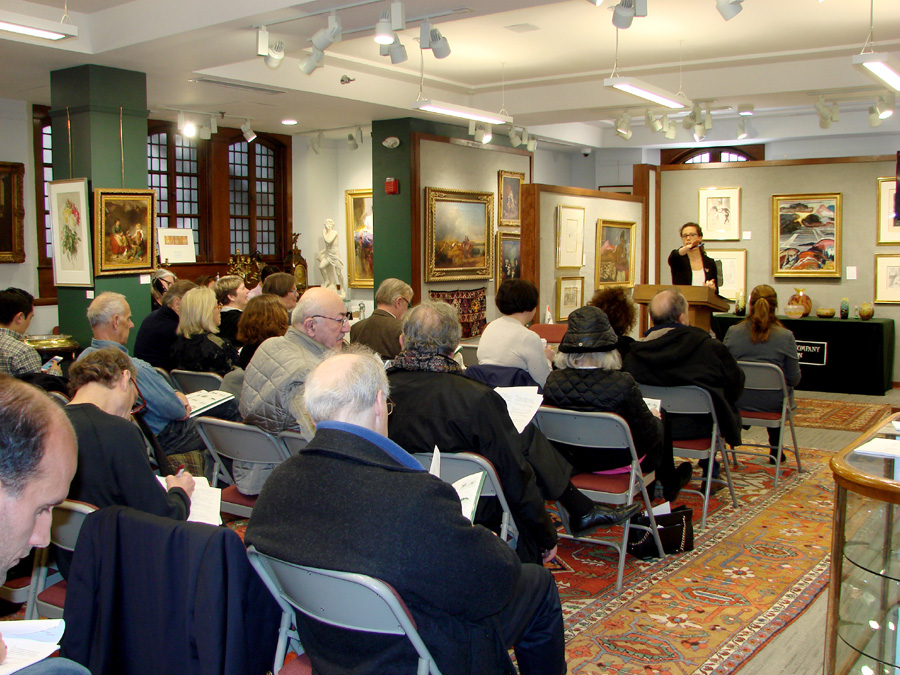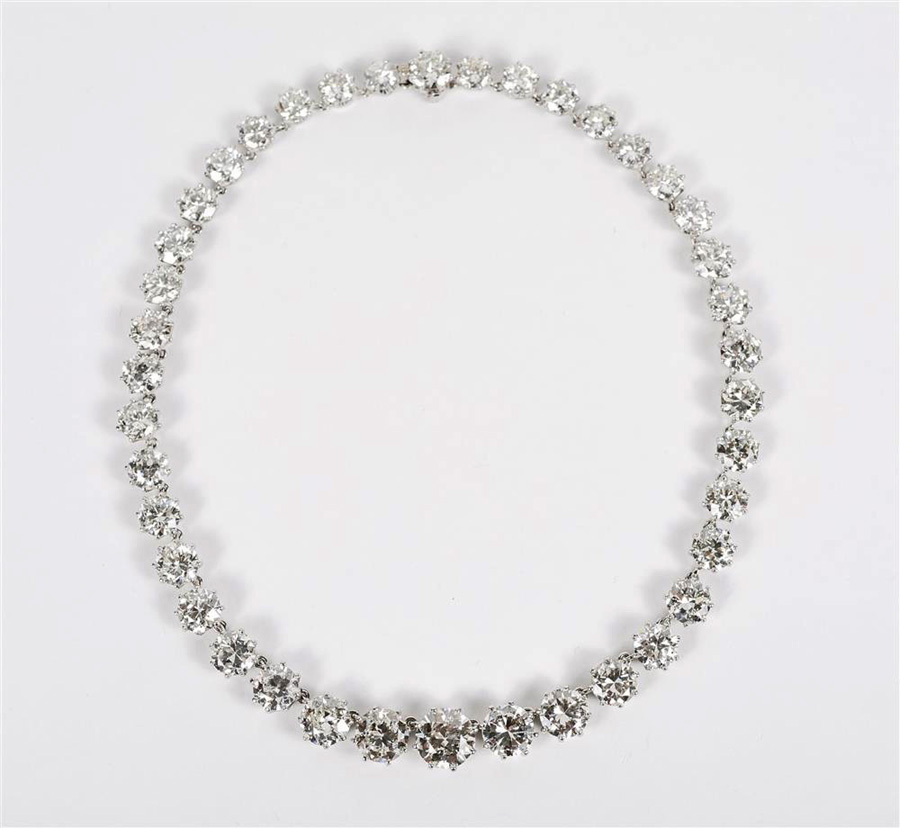
The top lot of the sale, more than doubling its high estimate, was this signed platinum and diamond riviere necklace made by Van Cleef & Arpels. Featuring 40 old European, transitional and mine cut diamonds, the largest of which weighed 4.24 carats, and with three others each weighing over 2.33 carats, the necklace attained $256,200.
Review By Rick Russack
Photos Courtesy Grogan and Company
BOSTON, MASS. — Grogan’s March 20 auction included 30 pieces of stunning jewelry from the estate of Helene Rabb Cahners-Kaplan, daughter of the founder of Stop & Shop Supermarkets. From that estate, and bringing the highest price of the sale, was a Van Cleef & Arpels platinum and diamond riviere necklace that sold for $256,200. Not only jewelry did well at this sale. Picasso ceramics, American paintings, Turkish tiles and French art glass also sold well. The sale grossed $1,250,000, with 280 of the 312 lots selling.
The necklace featured 40 old European, transitional and old mine-cut diamonds; the largest four being old European-cut stones weighing about 4¼, 2¾, 2½ and 21⁄3 carats. The necklace was signed with a hallmark on the clasp. Eleven phone lines chased this lot, and it did not take long for the necklace to reach its high. It was the most expensive item that auctioneer and jewelry department head Lucy Grogan had ever sold.
The sale started off with 179 lots of jewelry. Bringing the second highest price of the day at $42,700 was a pair of platinum and diamond earrings from the same estate. Each was set with a large, old European-cut diamond. One weighed 4.57 carats and the other weighed 4.45 carats with white gold posts and mounts. An 18K yellow gold, diamond, onyx and gemset “panthere” pendant and necklace by Cartier brought $19,520. The pendant was set with full-cut diamonds, round polished onyx and pear-shaped emeralds suspending a gold link fringe, and the necklace had matching links. Each was signed and numbered.
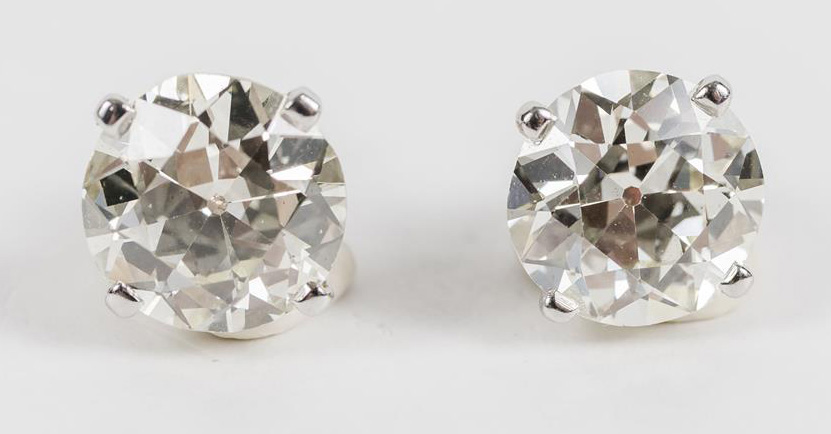
Platinum earrings, set with old European-cut diamonds, each weighing about 4.5 carats, went out at $42,700, more than double the estimate.
Bringing $33,550 was a platinum and diamond ring that had an old European-cut diamond weighing 3.6 carats within an open-work setting featuring full and single-cut diamonds. It showed some wear, and two of the single-cut diamonds were missing. Not everything was bringing five-figure prices. A 14K yellow gold, platinum, enamel, citrine, diamond and pearl brooch by Riker Brothers fetched $610, a 14K yellow gold seed pearl and gem-set necklace reached $793, and a 14K gold, amethyst, peridot and diamond brooch went for $1,037. When asked about her personal favorite piece of jewelry in the sale, Lucy Grogan pointed to a platinum, turquoise and diamond necklace that realized $27,450.
Perhaps not exactly considered jewelry, an Alfred Langlois yellow gold and enamel cigarette case, circa 1930, achieved $33,500. The cover had an ornate peacock design in raised blue and green enamel, with intricate gold work, and the case had the makers’ mark. Grogan’s catalog noted that “Alfred Langlois was among Van Cleef & Arpels’ most talented boîtiers, or box makers. Beginning in 1927, Langlois produced highly sophisticated enamel decoration in the Chinese taste and Persian carpet-like designs. (Coffin, Set in Style: The Jewelry of Van Cleef & Arpels, page 24). An almost identical cigarette case by Van Cleef & Arpels was exhibited at the Cooper Hewitt Museum in 2011 in conjunction with the publication of Coffin’s book.” The original drawing for that case exists in the Van Cleef & Arpels archives and is reproduced in Grogan’s sale catalog.
An important painting by Frank Shapleigh (American, 1842–1906) appeared to carry a low estimate and that turned out to be true. It was a waterfront scene near Portsmouth, N.H., titled “Little Harbor and Old Wentworth House, New Castle, N.H.” The Wentworth house was the home of Benning Wentworth, New Hampshire’s first royal governor. It was built in 1750, cobbled together from existing houses. The house still stands and is one of the first historic houses opened to the public, with tours beginning in the 1840s. It is still open to the public, a National Historic Landmark, and is virtually unchanged since the Wentworth days. The painting carried an estimate of $2/3,000 but its final price was much more in line with its importance, reaching $33,550. Shapleigh had a strong connection to New Hampshire, painting many White Mountains scenes and he was artist-in-residence at the Crawford House, one of the Grand Hotels, in Crawford Notch. Hopefully, the painting found its way back to New Hampshire.
The Shapleigh was not the only American painting to far exceed estimates. “Roses,” a watercolor by Paul de Longpre (French, 1855–1911), signed and dated “Los Angeles, 1903,” earned $30,500. It depicted red and white roses, with thorny stems of green foliage. “Rockport Float” by Emile Albert Gruppe (American, 1896–1978), an oil on canvas scene of the Rockport, Mass., harbor with several sailboats and buildings, realized $18,300. Gruppe was a member of the Rockport Art Association, and his paintings of that area are his most sought-after. Another Gruppe, “Mending Nets,” achieved $7,930.
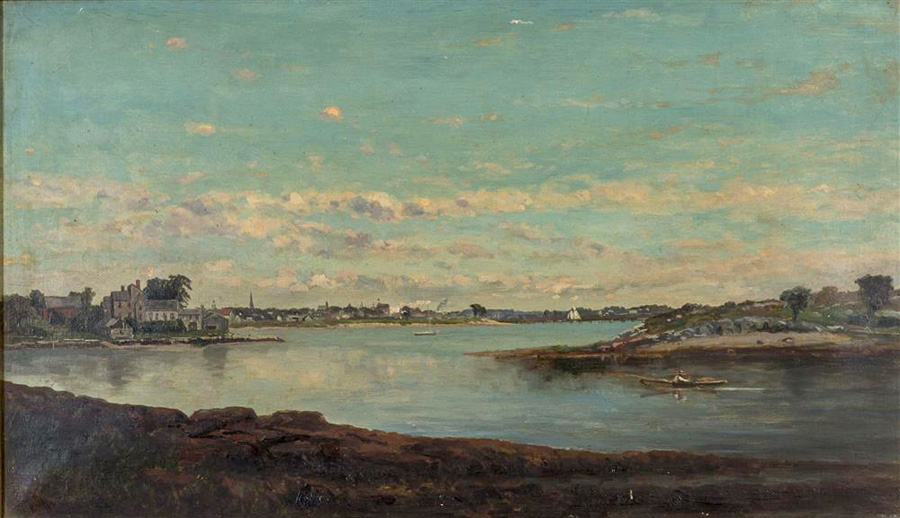
“Little Harbor and Old Wentworth House, Newcastle, NH” by Frank Shapleigh (American, 1842–1906) had a very low estimate but made its way to a price commensurate with its historic importance. It achieved $33,500.
A pair of watercolors of birds by Athos Menaboni (Italian American, 1895–1990), also did well, ending up at $10,370. One depicted a pair of Eastern Bluebirds and the other was a pair of Eastern Kingfishers. There were three oils by Joseph McGurl (American, b 1958). “Boston Harbor, 1990” went for $9,760 to an Internet bidder. As with the jewelry, there were nice paintings that one could take home for less than $1,000. A still life painting by George W. Seavey, (American, 1841–1916) reached $671 and a folky ship painting by Domingo Manso, probably a Nineteenth Century Cuban painter, seemed low at $793. An oval pair of French miniature portraits in gilt-metal frames, set with turquoise stones, fetched $335. One was signed Mariat and the other was signed Loboua. Another miniature, this one of Madame de Pompadour, by Anne Vallayer-Coster (French, 1744–1818), achieved $3,660 against an estimate of $700.
Pablo Picasso, (French, 1881–1973) was represented by three items. An aquatint etching, “Femme au Fauteul et Nu Assis” reached $6,100. Two ceramic pieces did well. “Personnage avec Mains sur les Hanches,” marked Edition Picasso Madoura and stamped Edition Picasso and Madoura Plein Feu on the base, earned $32,940, and the other ceramic piece, “Woman Lamp,” 26/220, with the same markings, brought $17,880. Also of interest were several pieces of French art glass. A signed Galle “Bleeding Heart” bulbous cameo vase, with red over a yellow ground, achieved $4,500, and a signed Daum Nancy cameo glass bowl, decorated with blue coneflowers, reached $4,270. A signed Lalique “Ondines” bowl with a molded mermaid, ended up at $1,037.
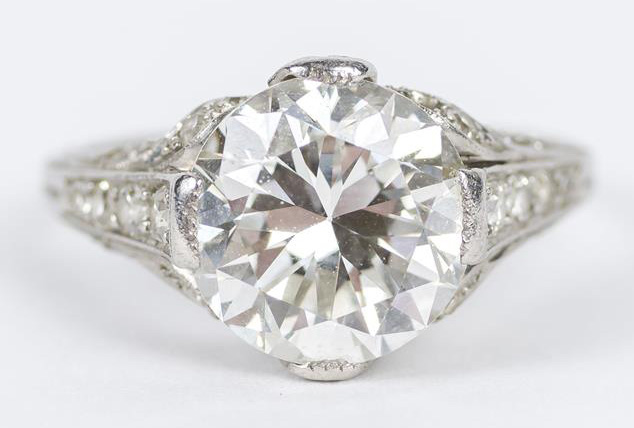
The large diamond in this platinum ring weighed 3.6 carats. In an open-work setting with full and single-cut diamonds, it fetched $33,500.
Rounding out the sale, a collection of 15 10-inch-square Turkish tiles, possibly dating to the Seventeenth Century, mounted as a table top, tripled estimate to earn $30,500.
Michael Grogan knows Oriental rugs, and this sale had a Heriz carpet, 8 feet by 15 feet 10 inches, circa 1900, that finished at $17,080. A Turkish silk and metallic thread Hereke, a circa 1970 carpet, sold for $7,320.
After the sale, Antiques and The Arts Weekly discussed with Michael two particular items in the sale; a gouache by Alexander Calder and an oil by Marsden Hartley. The Calder was the cover lot in the catalog, but it was withdrawn from the sale when Grogan learned that it was not authentic. He said, “We all continue to learn. After we prepared the catalog we checked with the Calder Foundation, in New York, and learned that during the 1980s, forgers working in Italy recreated Calder’s works. I had not been aware that there were fakes on the market, but this one was, and we pulled it. We want to be as sure as we can be about what we’re selling.”
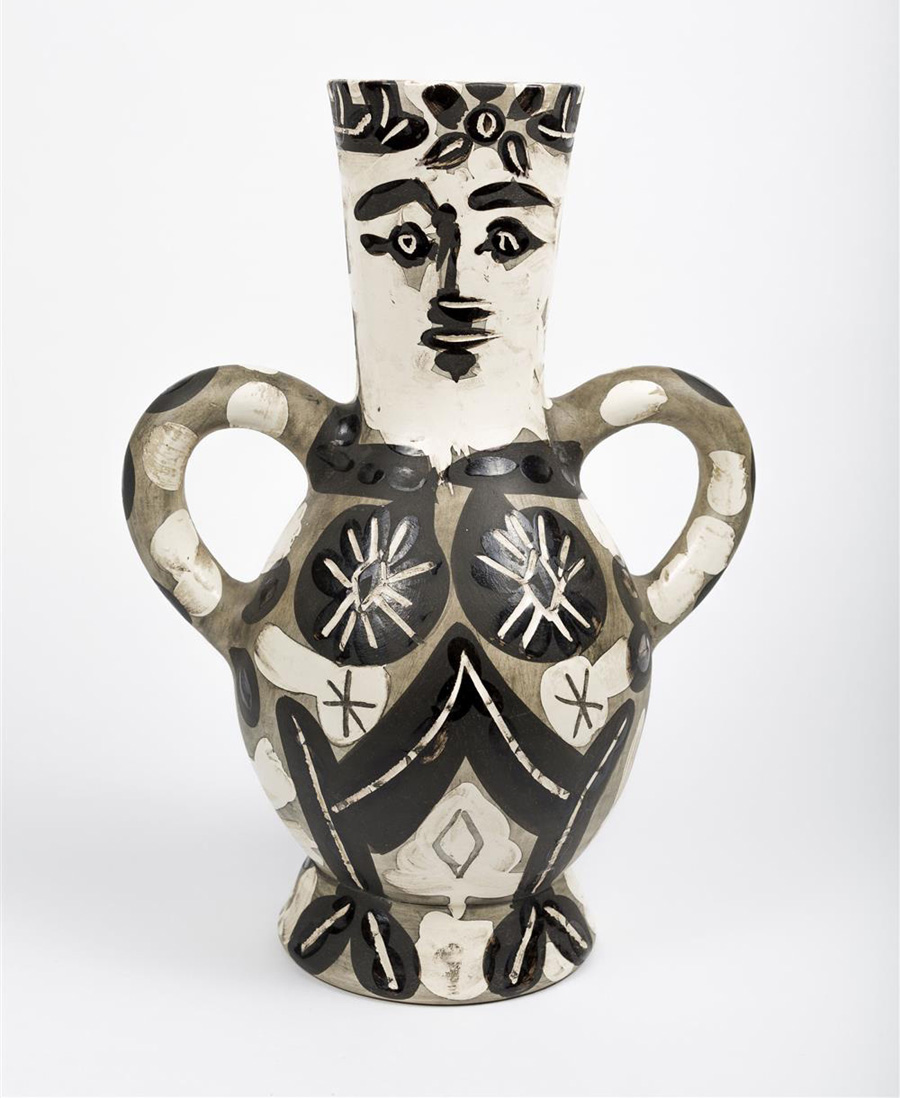
Two ceramic pieces by Pablo Picasso (French, 1881–1973) were offered in the sale. This one went out for $32,940.
As far as the Hartley is concerned, at the time the catalog was printed, the Grogans were not certain that the painting was actually by Hartley. Lucy Grogan said that the work was atypical for Hartley as was the signature. She said they decided to be conservative with their listing, but that they continued to research the work. Although it was signed and had a label on the back from Edith Gregor Halpert’s Downtown Gallery identifying it as a Hartley, the Grogans were cautious, and so simply cataloged it as “American School.” Continuing to research it, they found an image of the painting in the Archives of American Art, verifying the Downtown Gallery provenance. They recataloged it with the proper identification and a revised estimate. Although the painting did not sell, Grogan has established its authenticity, and its next owner can be confident of what they’re buying.
Michael Grogan went on to say, “Overall, we were very pleased with the sale. We aim for a certain average lot price and we liked the totals. There are always surprises, and the painting of the roses by Paul de Longpre was one. Another was the Shapleigh of Little Harbor and the Wentworth House. Generally speaking, I was pleased to see the level of interest, with multiple buyers seeking the same items. It’s a nice change from the last few years when sometimes we were selling things on single bids. That didn’t happen this time.”
All prices reported include the buyer’s premium. For more information, www.groganco.com or 617-720-2020.

